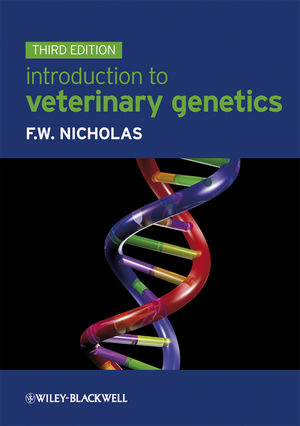
Introduction to Veterinary Genetics
Wiley-Blackwell (Verlag)
978-1-4051-6832-8 (ISBN)
The concepts of veterinary genetics are crucial to understanding and controlling many diseases and disorders in animals. They are also crucial to enhancing animal production. Accessible and clearly presented, Introduction to Veterinary Genetics provides a succinct introduction to the aspects of genetics relevant to animal diseases and production. Now in its third edition, this is the only introductory level textbook on genetics that has been written specifically for veterinary and animal science students. Coverage includes: basic genetics, molecular biology, genomics, cytogenetics, immunogenetics, population genetics, quantitative genetics, biotechnology, and the use of molecular tools in the control of inherited disorders.
This book describes in detail how genetics is being applied to artificial selection in animal production. It also covers the conservation of genetic diversity in both domesticated and wild animals.
New for the Third Edition:
End-of-chapter summaries provide quick recaps.
Covers new topics: epigenetics, genomics and bioinformatics.
Thoroughly revised according to recent advances in genetics.
Introduction to Veterinary Genetics is still the only introductory genetics textbook for students of veterinary and animal science and will continue to be an indispensable reference tool for veterinary students and practitioners alike.
Frank Nicholas is Emeritus Professor of Animal Genetics in the Faculty of Veterinary Science at the University of Sydney. He has edited and co-authored several books about genetics and one about Charles Darwin, and he created and maintains Online Mendelian Inheritance of Animals (OMIA; omia.angis.org.au), a comparative knowledge-base of genetic disorders and other familial traits in non-laboratory animals.
Preface 1 Basic genetics
Chromosomes
Meiosis and mitosis
The biochemistry of inheritance
What is a gene?
Gene regulation
Mutation
Genes, alleles, and loci
Simple or Mendelian inheritance
Linkage
Inactivation
Types of DNA
Further reading
Appendix 1.1 Banded karyotypes of domestic species
2 Molecular biology
Restriction enzymes
Recombinant DNA and DNA cloning
Complementary DNA
DNA sequencing
Polymerase chain reaction
Southern analysis and related technologies
DNA expression microarrays
The detection of variation in base sequence
Veterinary diagnosis
Variable number of tandem repeats (VNTR), DNA fingerprints, and microsatellites
Single nucleotide polymorphisms (SNPs)
Copy number variation (CNV)
Gene mapping
Whole-genome sequence assembly
Production of polypeptide from cloned DNA
Transgenesis
Antisense technology
RNA interference
Further reading
3 Single-gene disorders
Inborn errors of metabolism
Sex-limited inheritance
Genetic heterogeneity of disease
Type of gene action and type of disease
Phenocopies
A sample of single-gene disorders
A revolution in mapping and identifying the causal mutation of single-gene disorders
Further reading
Appendix 3.1 A sample of single-gene traits that have been characterized at the molecular level
4 Chromosomal aberrations
Abnormal chromosome number
Abnormal chromosome structure
Chromosomal aberrations in cancer
Evolution of karyotypes
Interspecific hybridization
Freemartins
Biological basis of sex
Classification of intersex 116
A sample of chromosomal aberrations
Further reading
Appendix 4.1 A sample of chromosomal aberrations in animals
5 Single genes in populations
Gene and genotype frequencies
Random mating
The Hardy–Weinberg law
Extensions to the Hardy–Weinberg law
Selection and mutation
Genetic drift and the founder effect
Extending population genetics to more than one locus
Further reading
6 Familial disorders not due to a single gene
Liability and threshold
The multifactorial model
More than one threshold
Some final points
Further reading
7 Is it inherited?
General evidence for a genetic aetiology
The four types of simple, Mendelian inheritance
Studying and analysing the data
Further reading
8 Immunogenetics
Antibodies
Red-cell antigens
The major histocompatibility complex (MHC)
Further reading
9 Pharmacogenetics
Genetic polymorphisms affecting drug metabolism
Genetics and anaesthesia
Warfarin resistance
Multifactorial pharmacogenetics
Further reading
10 Hosts, parasites, and pathogens
Host–pathogen interactions
Resistance in hosts
Resistance in parasites and pathogens
Control of parasites and pathogens
Increasing the level of resistance in hosts
Further reading
11 Single genes in animal breeding
Coat colour
Examples of coat-colour genes
Carpet wool
Prolificacy in sheep
Polledness
Muscular hypertrophy in cattle and sheep
Dwarf poultry
Genes for sexing chickens
Pedigree checking
Further reading
12 Relationship and inbreeding
The inbreeding coefficient
Relationship
The inbreeding coefficient revisited
A general expression for relationship and inbreeding
The base population
Inbreeding in populations
Inbreeding depression
Further reading
13 Quantitative variation
Quantitative traits
The performance of an individual animal
The differences between animals
Heritability
Correlations between traits
Quantitative trait loci (QTL)
Further reading
14 Selection between populations
Comparison between populations
Genotype–environment interaction
Further reading
15 Selection within populations
Estimated breeding values and accuracy of selection
Clues to a candidate’s breeding value for a trait
Combining clues from more than one source
Best linear unbiased prediction (BLUP)
Correlated traits
Selection for more than one trait
The importance of inbreeding and genetic drift
Sire-reference schemes
Marker-assisted selection (MAS) and genome-wide selection (GWS)
Further reading
16 Breed structure
The traditional pyramid
Closed-nucleus breeding schemes
Open-nucleus breeding schemes
Further reading
17 Crossing
Regular crossing
Crossing to produce a synthetic
Grading-up
Further reading
18 Selection and regular crossing
Selection
Selection and regular crossing
Further reading
19 Biotechnology and the future
Artificial insemination (AI)
Multiple ovulation and embryo transfer (MOET)
In vitro maturation (IVM) and in vitro fertilization (IVF) of ova
Control of sex ratio
Recombinant proteins
Transgenesis
Animal cloning
Further reading
20 Conservation genetics
Measurement of genetic diversity within populations
Measurement of genetic diversity among populations
Importance of genetic diversity
Loss of genetic diversity
Conservation of genetic diversity
Further reading
21 Genetic and environmental control of inherited disorders
Environmental control of inherited disorders
Genetic control of single-gene disorders
Gene therapy
Genetic control of multifactorial disorders
Genetic control – some final points
Crossing: thinking outside the square
Further reading
Glossary
Index
| Verlagsort | Hoboken |
|---|---|
| Sprache | englisch |
| Maße | 173 x 246 mm |
| Gewicht | 644 g |
| Themenwelt | Naturwissenschaften ► Biologie ► Genetik / Molekularbiologie |
| Veterinärmedizin ► Klinische Fächer ► Pathologie | |
| ISBN-10 | 1-4051-6832-3 / 1405168323 |
| ISBN-13 | 978-1-4051-6832-8 / 9781405168328 |
| Zustand | Neuware |
| Haben Sie eine Frage zum Produkt? |
aus dem Bereich


